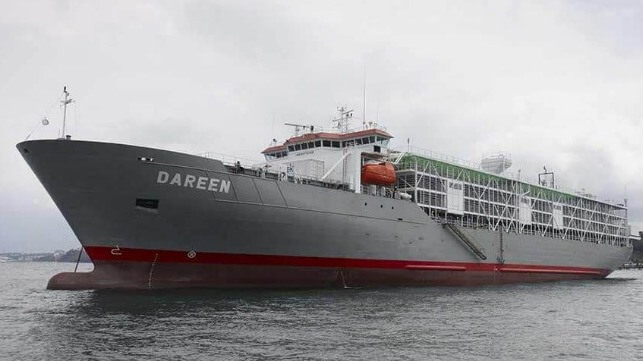Last Livestock Carrier Departs New Zealand as Ban Goes into Effect

New Zealand completed its two-year phase out of livestock exports with the controversy on the practice continuing up to the departure of the last vessel. The phase-out of the business, which was reported to be valued at US$325 million in 2022, was in response to ongoing protests by animal rights activities, reports of poor conditions on the ships, and several high-profile losses of ships resulting in the death of the crew and the animals.
Agriculture Minister Damien O’Connor confirmed the departure of the last vessel, the Dareen (7,285 dwt) operated by Mira Shipping out of Dubai. Registered in Panama, the vessel is 29 years old. At 458 feet in length, the ship is reported to have a maximum capacity of 7,000 cattle. The vessel however under New Zealand’s interim restrictions put in place in 2021 was limited to 90 percent density and required to have a 20 percent feed reserve in case of delays or other problems during the voyage.
The Dareen arrived in Timaru, New Zealand, a port on the east coast of the South Island, on April 18. The export license allowed for up to 6,253 cattle, although under the restrictions each animal needed to be inspected before boarding. It was anticipated that the vessel would carry less than the license with the final count being reported at 6,090. The cattle were trucked from a farm and loaded aboard the vessel which departed Tiramu shortly before 0600 local time on April 20. The vessel is expected to reach Huanghua, China on May 9.
The official ban on live exports begins on April 30 but the ministry confirmed that no additional export licenses have been issued after the Dareen. The ministry said the two-year transition period had been set to provide farmers time to adjust their business and adapt to the limits. Minister O’Connor dismissed recent talk of restarting live export by sea saying that consumers overseas were also increasingly taking animal welfare and issues of sustainability seriously. He noted that others countries are following New Zealand’s example highlighting that Australia has also moved to phase-out live export of sheep.
“Since 2015, live exports by sea have represented only 0.32 percent of primary sector export revenue. Whilst we acknowledge the economic benefits for some farmers, we also have to protect the international reputation of our annual NZ$53 billion (US$32.5 billion) primary export industry,” said O’Connor. “This is why we initiated the review in 2019 and subsequently made the decision to cease live exports by sea by the end of April 2023.”
Animal rights activists were planning a celebration for April 30 to mark the official end of the live export trade. This week, however, the group Save Animals from Exploitation nonetheless repeated its allegations of cruelty accusing the New Zealand farmer of holding the animals in poor conditions prior to their last export shipment. They released a video showing the animals in a muddy field saying there was no feed and no grass, while the farmer denied the allegations saying the animals were well cared for and in good health before their export.
The ministry said it was aware of the video and would be investigating. They also told local media that the shipment would only be permitted to depart once inspectors confirmed that all the conditions of the export licenses were being met.
New Zealand had previously imposed a temporary moratorium and then set restrictions on the trade after the September 2020 loss of the Gulf Livestock 1 carrier. The vessel sank in a storm off Japan killing 41 crewmembers and around 6,000 head of cattle. Only two crewmembers survived the disaster which gained worldwide attention.
